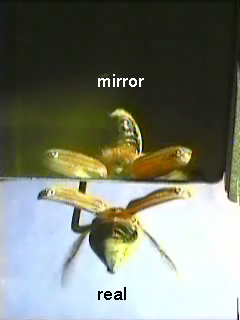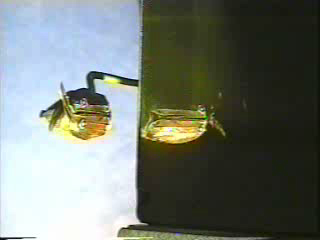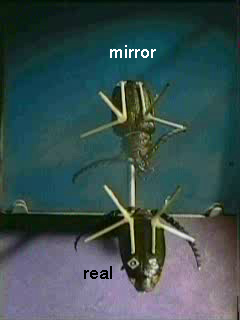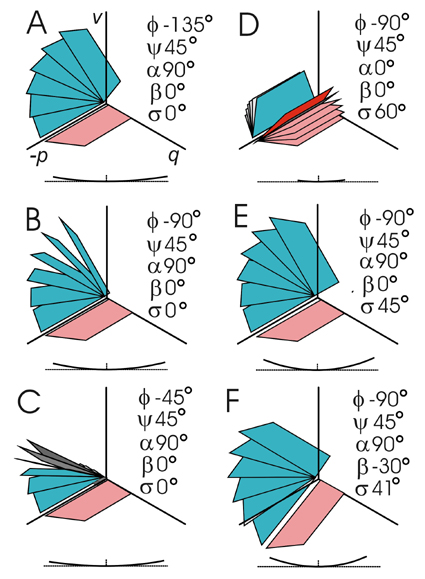Leonid Frantsevich, Zhendong Dai, Wei Ying Wang,
Yafeng Zhang
Geometry of Elytra Opening and Closing in some
Beetles (Coleoptera, Polyphaga).
Journal of Experimental Biology 2005, 208: 3145-3158.
Summary. Elytra in beetles move actively, driven
by their own muscles, only during transient opening and closing.
The kinematics of these movements has been inadequately described,
sometimes controversially. Our goal was a quantitative 3D description
of diverse active movements of the elytra, in terms of directions
of the axes of elytra rotation.
Broad opening and closing was videorecorded in
beetles, tethered by the mesothorax, and has been analyzed frame
by frame. For tracing, small dots or straw arms have been glued
to the elytra. Opening and closing traces coincided. The trace
of the elytron apex was a flat circular arc about the axis of
abduction-adduction (AAA). The rising hemiaxis pointed contralaterad.
The AAA was tilted forwards in Melolontha hippocastani, Allomyrina
dichotoma and Prionus coriarius but backward in Chalcophora mariana.
In Cetonia aurata, AAA had low elevation and a strong backward
orientation. If another elytra-fixed point was traced in addition
to the apex (in M. hippocastani and P. coriarius), then secondary
rotation about the sutural edge (supination on opening) occured.
Modeling of abduction-adduction revealed that
the elytron rose on opening if the AAA pointed contralaterad.
The more the AAA was tilted forward, the more negative was the
attack angle of the open elytra. The negative attack angle was
partly compensated by positive body pitch and, more effectively,
by supination of the costal edge about the sutural edge. The initial
stage of opening included elevation of closed elytra (by 10-12°)
and partition to the sides, combined with an inward turn (<
2-3°). Axis of rotation at this stage presumably coincided with
the AAA. Movement of one elytron with respect to the opposite
one at the beginning of opening followed the shallow arc convex
down. The geometry of this relative movement describes the initial
partition of the elytra and release of the sutural lock.
Tethered flight of Melolontha hippocastani
 |
The insect is filmed under a skew mirror:
the top image is in the mirror, the bottom one is real.
Frame coordinates of any corresponding points in two images
are transformed into 3D coordinates in the global space.
In the experiment, a videocamera is tilted about 90°
to fit both images to the landscape format. |

Dots on the wing are used for easy tracing
Traces of landmark dots on the elytra
in a cockchafer Melolontha hippocastani
in two projections in the external reference system during opening
(hollow dots)
and closing (black dots).
Tethered flight of a cerambycid Prionus coriarius
 |
Light orthogonal tripods are glued to the elytra. They
show complicated rotation of the elytron during opening
and closing. |
The apex of the elytron rotates
down a flat circular arc, the same one during opening (hollow
dots) and closing (black dots). The axis of rotation is skew with
respect to the body. Parallel traces (box in the top panel) are
simultaneous rising of both elytra at the start of opening and
sinking down at the finish of closing. Traces of flight strokes
of the elytra after opening and before closing are seen as mushroom
heads: their axes of rotation are parallel to the longitudinal
body axis. Moreover, during opening and closing the elytron rotates
additionally about the costal edge, supinating or pronating.

Modeling of elytra motion. Left
column - abduction of the left elytron by 90° versus different
azimuth of the rotation axis (AAA). The less the azimuth, the
more the open elytron tends to negative attack angle. Right column
- supination combined with abduction. D - supination of two elytra
without abduction. E, F - supinatory compensation of the attack
angle to zero in the abducted left elytron. Initial position of
elytra in A-E is horizontal, in F bent down. Angular variables
are indicated in the panels: azimuth φ, elevation ψ,
abduction α, bend β, supination σ. Isometric view
in the body-fixed reference frame.
Profile of the frictional locking
sutural structures in a dung beetle, Catharsius molossus
is typical for most beetles. We must take into account that elytra
move relative each other during unlocking or locking. The trajectory
of relative motion is not a simple circle.
We model it for the imaginary 360°
rotation of each elytron: A – closed and open positions of two
elytra, B – intermediate stages of opening in the body-fixed coordinates,
C –an observer sitting on the moving elytron views the opposite
elytron, also moving, D – relative trajectory of the left elytron
in the right elytron fixed reference system.
In some beetles with extremely curved trajectories
of divergence, the sutural lock is adopted to rotation during
unlocking:
Profile of the sutural locking structure
in a cetoniid Rhomborhina unicolor .
Continuation of this research see
in
“Double rotation of the opening (closing)
elytra in beetles (Coleoptera)
|



